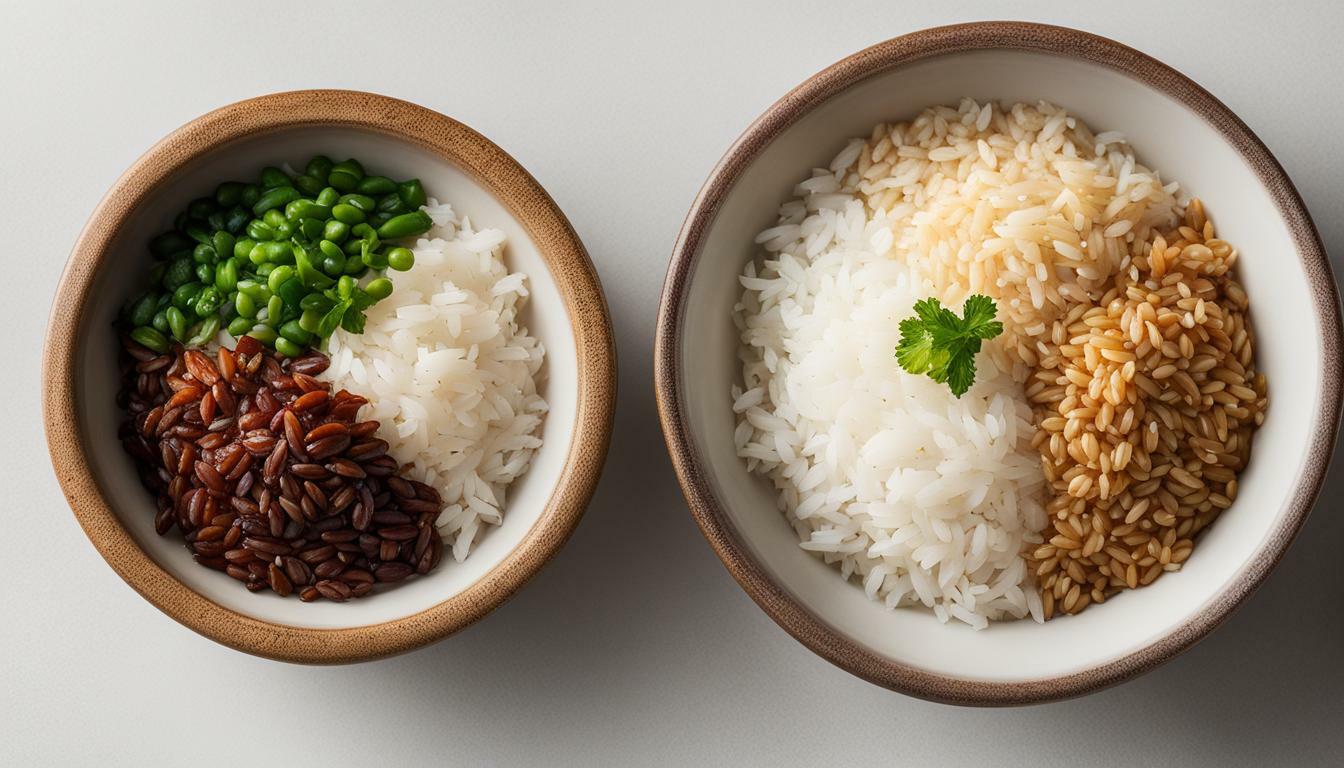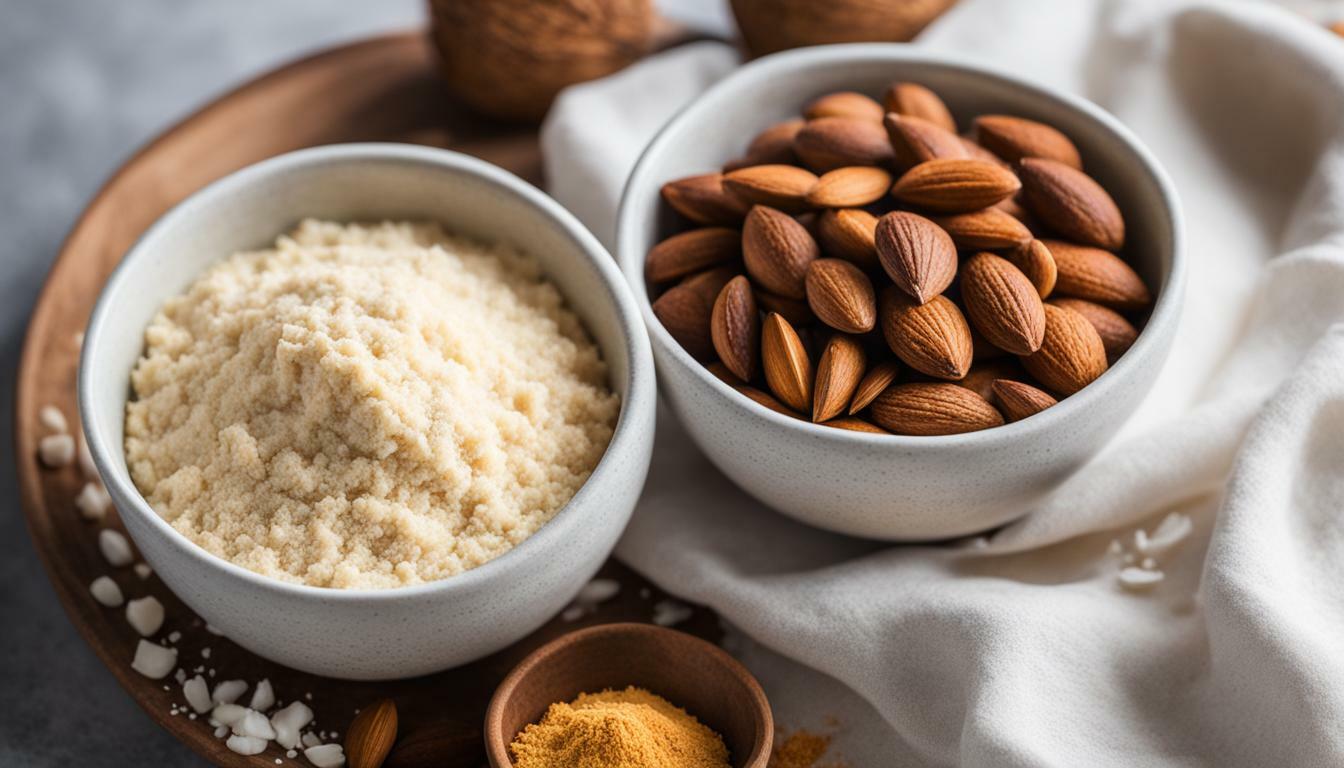When it comes to staple foods, rice is among the most popular and widely consumed around the world. However, not all rice is created equal, and there are significant differences between white rice and brown rice that are worth exploring.
While both come from the same plant, the main difference between the two is that white rice has been stripped of its bran and germ, while brown rice retains these nutritious components. This crucial difference affects several factors, including their nutritional content, cooking method, taste, and potential health benefits.
Key Takeaways:
- White rice and brown rice are two common types of rice, with significant differences in nutritional value and potential health benefits.
- White rice has been stripped of its bran and germ, while brown rice retains these nutritious components, leading to differences in fiber, micronutrients, and overall nutrient profiles.
- Choosing between white rice and brown rice depends on individual health goals and dietary needs.
Nutritional Differences Between White Rice and Brown Rice
While both white and brown rice are popular staples in many households, they differ significantly in nutritional value. Brown rice is a whole grain, meaning it contains all parts of the grain, including the bran, germ, and endosperm. On the other hand, white rice has had the bran and germ removed, leaving only the starchy endosperm.
One of the biggest nutritional disparities between white and brown rice is their fiber content. Brown rice is a much better source of fiber, as it contains the bran layer that is rich in this nutrient. In fact, just one cup of cooked brown rice provides 3.5 grams of fiber, while the same amount of white rice contains only 0.6 grams. This difference is important because fiber plays a crucial role in digestive health and can help promote feelings of fullness to support healthy weight management.
Brown rice also contains more micronutrients than white rice. While both types of rice contain some essential minerals and vitamins, the bran layer in brown rice adds extra nutrients like magnesium, phosphorus, zinc, and B vitamins. These micronutrients are important for a range of bodily functions, including bone health, energy production, and brain function.
Overall, when it comes to nutritional value, brown rice is the clear winner. Its higher fiber content and extra nutrients make it a healthier choice than white rice for most people.
Health Benefits of Brown Rice
While both white rice and brown rice are grains, brown rice has several nutritional benefits that make it a healthier option. Brown rice is a whole grain, which means it contains all parts of the grain including the bran, germ, and endosperm.
The bran layer of brown rice contains fiber, which helps to regulate the digestive system and keep you feeling full. In contrast, white rice has had the bran layer removed, which means it contains less fiber and can lead to digestive problems such as constipation.
Brown rice is also a good source of several key nutrients, including magnesium, selenium, and vitamin B6. These nutrients are important for maintaining good health and reducing the risk of chronic diseases such as heart disease and diabetes.
Additionally, brown rice has a lower glycemic index than white rice, which means it is digested more slowly and does not cause a rapid increase in blood sugar levels. This makes brown rice a better option for people with diabetes or those looking to manage their weight.
In summary, choosing brown rice over white rice can provide several health benefits due to its higher fiber content, nutrient density, and lower glycemic index. If you are looking to improve your overall health and wellbeing, consider incorporating brown rice into your diet instead of white rice.
Health Considerations of White Rice
While white rice is a popular staple food in many cultures worldwide, it may not be the healthiest option due to its limited nutrient content. Unlike brown rice, white rice is stripped of its bran and germ, resulting in lower fiber and nutrient content.
One of the main drawbacks of white rice is its impact on blood sugar levels. White rice is a high glycemic index food, which means it can cause a rapid increase in blood sugar levels. This can be particularly problematic for individuals with diabetes or other conditions that require blood sugar regulation.
Additionally, white rice is lower in fiber compared to brown rice. Fiber is essential for digestive health and can help regulate bowel movements, reduce cholesterol levels, and promote feelings of fullness. A lack of fiber in the diet is associated with an increased risk of heart disease, diabetes, and other chronic conditions.
Despite its drawbacks, white rice can still be a part of a healthy diet when consumed in moderation and combined with other nutrient-dense foods. It is also a more easily digestible option for individuals with digestive issues.
Below is a table comparing the pros and cons of white rice vs brown rice:
| White Rice | Brown Rice | |
|---|---|---|
| Nutrient Content | Low | High |
| Fiber Content | Low | High |
| Glycemic Index | High | Low |
| Taste and Texture | Mild, soft | Nutty, chewy |
| Cooking Time | Shorter | Longer |
Overall, when deciding between white and brown rice, it’s important to weigh the pros and cons based on one’s individual health needs and goals. While white rice may be a convenient and affordable option, brown rice offers significantly more nutrients and fiber, contributing to better overall health in the long run.
Cooking and Taste Differences Between White Rice and Brown Rice
Brown rice and white rice are not only different in terms of nutritional content but also in their cooking methods and taste profiles. Here are some differences you should consider when deciding which one to choose.
Cooking Methods
White rice is quicker and easier to cook than brown rice. It takes approximately 15-20 minutes to cook white rice, compared to brown rice, which takes around 40-45 minutes. Brown rice requires more water than white rice, around two cups of water per cup of rice, whereas white rice requires 1.5 cups of water per cup of rice.
A common mistake when cooking brown rice is not allowing it to steam after cooking. After turning the heat off, let the rice steam for 10-15 minutes. This will help it become fluffier and easier to eat.
Taste Differences
Brown rice has a nutty flavor and a chewy texture, while white rice has a mild flavor and a soft texture. Brown rice is often used in recipes that require a rice dish with a distinct flavor, such as in pilafs or salads. White rice is commonly used in dishes such as sushi or rice pudding, where the flavor of the rice may not be as important.
Culinary Uses
Brown rice is a versatile ingredient that can be used in many dishes, including salads, casseroles, and stir-fries. It can also be used as a substitute for white rice in most recipes, adding more fiber and nutrients to the dish.
White rice is commonly used in Asian and Indian cuisine, as well as in dishes where its mild flavor complements the flavors of other ingredients, such as risotto or paella.
Conclusion
In conclusion, brown rice and white rice have different cooking methods, taste profiles, and culinary uses. Brown rice has a nutty flavor and chewy texture and is often used in dishes where the rice’s flavor is important. White rice has a mild flavor and soft texture and is commonly used in dishes where the rice’s flavor is not as important, such as sushi or rice pudding. Ultimately, it comes down to personal preference and nutritional needs when choosing between brown rice vs white rice.
Conclusion
As we have explored in this article, the difference between white rice and brown rice goes beyond their color and taste. Brown rice is the clear winner when it comes to nutritional value, boasting a higher fiber content and nutrient profile. Choosing brown rice over white rice can contribute to improved digestion, weight management, and overall health.
However, this doesn’t mean that white rice should be completely avoided. It can still be a part of a healthy diet when consumed in moderation. It’s important to consider individual health goals and dietary needs when deciding between the two.
Ultimately, the choice between white rice and brown rice comes down to personal preference and nutritional priorities. By understanding the differences between the two, you can make an informed decision that aligns with your health goals and resonates with your taste buds.
 Skip to main content
Skip to main content


